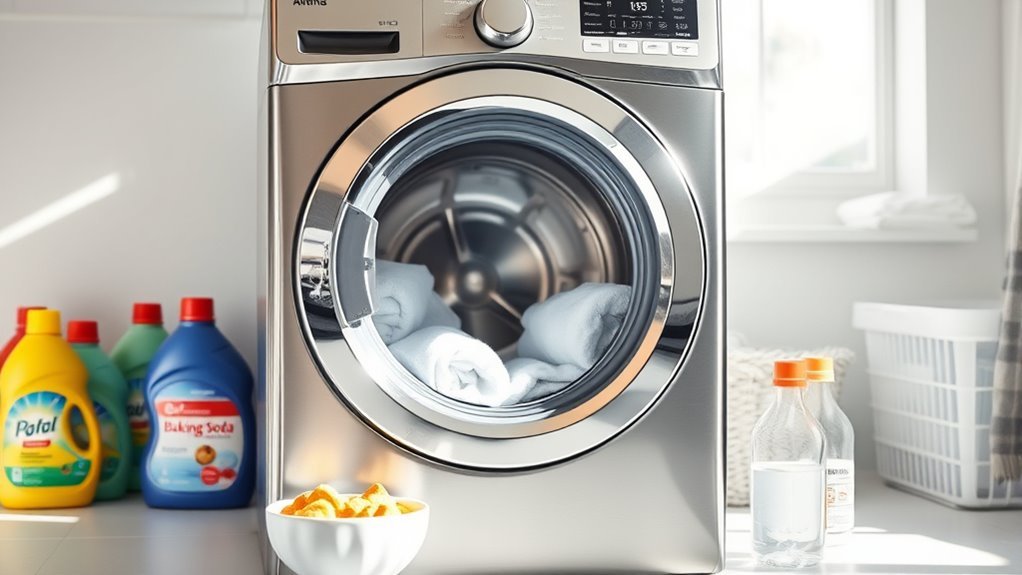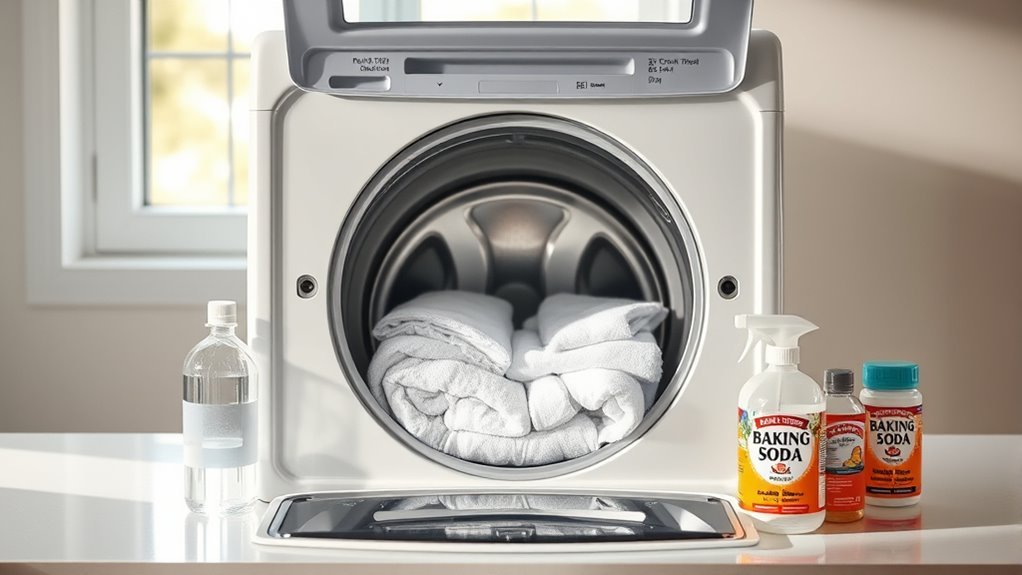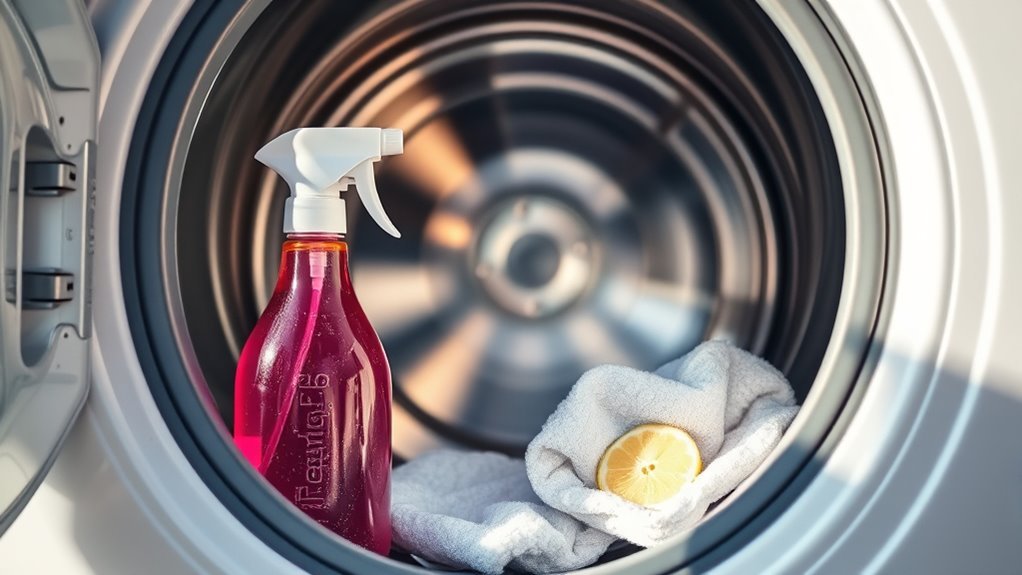Best Way to Sanitize Your Washer
The best way to sanitize your washer is to run a hot water cycle with either white vinegar or bleach, depending on your washer type. For top-loaders, add two cups of vinegar, run a cycle, then follow with baking soda and another hot cycle. Front-loaders benefit from cleaning the drum and rubber gasket with a cleaner and wiping them dry. Keeping the door open after use helps prevent mold and odors. Stick with these habits, and you’ll keep your washer fresh and clean—discover more tips to maintain it effectively.
Why Regular Washer Sanitization Is Important

Although your washer cleans your clothes, it can also harbor bacteria, mold, and mildew if not sanitized regularly. You might not realize it, but bacteria growth inside your machine poses health risks that go beyond just unpleasant odors. When you skip regular sanitization, these microbes can transfer to your clothes, potentially causing skin irritation or allergic reactions. By keeping your washer clean, you’re not just protecting your laundry—you’re safeguarding your health and your family’s well-being. Taking a few moments to sanitize your washer frees you from the worry of hidden germs thriving where you least expect them. It’s a simple step toward maintaining a fresh, healthy home environment, letting you enjoy the freedom of clean clothes without compromise.
Tools and Supplies Needed for Sanitizing Your Washer
Keeping your washer free from bacteria and mold means using the right tools and supplies to get the job done effectively. To maintain your laundry freedom, you’ll want reliable sanitizing solutions like bleach or specialized washer cleaners designed to kill germs without harming your machine. Along with these, gather essential cleaning tools such as a soft cloth, a scrub brush, and a toothbrush for those hard-to-reach spots. You might also want rubber gloves to protect your hands and a measuring cup to guarantee you use the correct amount of solution. Having these items ready makes the sanitizing process straightforward, so your washer stays fresh and safe to use. This way, you keep control over your laundry’s cleanliness without hassle or worry.
How to Sanitize a Top-Loading Washer

Wondering how to properly sanitize your top-loading washer? Take advantage of your top loader features and washer settings to keep it fresh and clean. Here’s a straightforward method:
Wondering how to sanitize your top-loading washer? Use its settings to keep it fresh and clean easily.
- Set your washer to the hottest water setting available.
- Add two cups of white vinegar directly into the drum.
- Run a complete wash cycle without any clothes.
- After the cycle ends, sprinkle half a cup of baking soda inside the drum.
- Run another hot water cycle to flush out residue and odors.
This routine uses your washer’s capabilities to fight grime without harsh chemicals. Regularly sanitizing this way guarantees your laundry stays clean, and your machine runs smoothly—giving you the freedom to enjoy fresh clothes every time.
How to Sanitize a Front-Loading Washer
To sanitize your front-loading washer, you’ll want to focus on cleaning the drum thoroughly and tackling any mold or mildew buildup. Using natural cleaners like vinegar and baking soda can help break down residue and keep things fresh. Let’s walk through the best steps to get your washer spotless and odor-free.
Cleaning Drum Thoroughly
One effective method to sanitize your front-loading washer is by thoroughly cleaning the drum, which can prevent mold and mildew buildup. Since drum materials and drum design vary, you want to tailor your approach to protect the integrity of your washer while keeping it fresh. Here’s what you can do:
- Use a soft cloth or sponge to avoid scratching the drum surface.
- Choose a cleaner compatible with your drum materials (stainless steel or plastic).
- Run a hot water cycle with bleach or a washing machine cleaner.
- Leave the door open after cleaning to let the drum air dry fully.
- Wipe down the rubber gasket around the drum to remove any residue.
Taking these steps guarantees your drum stays clean and your washer works efficiently without compromising its design.
Removing Mold and Mildew
Although mold and mildew can hide in hard-to-see places of your front-loading washer, tackling them is essential for keeping your machine sanitary and odor-free. You’ll want to focus on mold prevention and mildew removal by regularly inspecting rubber seals and detergent dispensers. Wiping these areas dry after each use cuts down moisture, the main culprit behind mold growth.
| Feeling | Action |
|---|---|
| Frustrated | Clean seals and gaskets |
| Relieved | Eliminate musty odors |
| Empowered | Maintain mold prevention |
| Free | Enjoy fresh laundry |
Using Vinegar and Baking Soda
Since your washer deals with dirt and detergent buildup regularly, using vinegar and baking soda is an effective way to sanitize it naturally. You’ll love how these simple ingredients harness vinegar benefits and the cleaning power of baking soda without harsh chemicals.
To sanitize your front-loading washer:
- Pour 2 cups of white vinegar into the detergent dispenser.
- Add 1/4 cup of baking soda directly into the drum.
- Run the washer on the hottest, longest cycle.
- Wipe down the door seal and drum after the cycle finishes.
- Leave the door open to air dry, preventing mold growth.
This method frees you from relying on synthetic cleaners and keeps your washer fresh, clean, and ready for every load.
Using Vinegar and Baking Soda for Effective Cleaning
Two common household items—vinegar and baking soda—can work wonders when it comes to cleaning your washer. You’ll love the vinegar benefits: it naturally breaks down soap scum, mineral deposits, and grime without harsh chemicals. Start by pouring two cups of white vinegar into the detergent dispenser. Run a hot water cycle to let the vinegar do its magic. Once that’s done, sprinkle half a cup of baking soda directly into the drum. Baking soda acts as a gentle abrasive and deodorizer, tackling odors and residue left behind. Run another hot cycle to rinse everything thoroughly. This simple combo not only cleans effectively but also helps maintain your washer’s performance, giving you the freedom from expensive and chemical-laden cleaners. It’s a smart, natural way to keep your machine fresh and efficient.
Preventing Mold and Mildew in Your Washer

How can you keep your washer free from mold and mildew? Embracing mold prevention and mildew deterrents guarantees your machine stays fresh, saving you from musty odors and potential damage. Here’s how you can take control:
- Leave the washer door open after each use to promote airflow and drying.
- Wipe down seals and gaskets regularly to remove trapped moisture.
- Use high-efficiency detergent sparingly to avoid residue buildup.
- Run monthly cleaning cycles with vinegar or bleach for deep sanitation.
- Remove wet clothes promptly to prevent dampness inside the drum.
Tips for Maintaining a Fresh and Clean Washer Between Deep Cleans
To keep your washer fresh between deep cleans, it helps to build simple daily habits like leaving the door open after use. Quick tricks like wiping down seals and running short hot cycles with vinegar can stop odors before they start. Regular attention goes a long way in preventing musty smells and keeping your machine in top shape.
Daily Maintenance Habits
Although deep cleaning your washer is essential, adopting daily maintenance habits can help keep it fresh and prevent buildup between thorough washes. Integrating simple daily routines into your washer upkeep guarantees your machine stays efficient and odor-free without extra hassle. Here’s how you can maintain that freedom from frequent deep cleans:
- Leave the door or lid open after each use to air out moisture.
- Wipe down the gasket and drum with a dry cloth to prevent mildew.
- Remove and clean the detergent dispenser regularly.
- Use the right amount of detergent to avoid residue buildup.
- Check and clean the filter to keep water flowing smoothly.
Quick Freshening Techniques
Wondering how to keep your washer smelling fresh without a full deep clean every time? Quick freshening techniques can save you time and keep your laundry routine hassle-free. Try using freshening sprays designed specifically for washers; they’re easy to apply and instantly combat lingering odors. You can also add a few drops of essential oils like lavender or tea tree to a damp cloth and wipe down the drum and door seal. These natural scents not only refresh your washer but also create a pleasant aroma for your next load. By incorporating these simple habits, you maintain a clean, inviting washer environment, giving you more freedom to enjoy laundry day without worrying about unpleasant smells.
Preventing Odors Regularly
Even if you don’t run a deep clean regularly, you can keep odors at bay with a few simple habits. Consistent washer care is key to odor prevention and helps you enjoy fresh laundry without hassle. Here’s how to maintain your washer’s freshness between deep cleans:
- Leave the washer door open after each use to let moisture escape.
- Wipe down the rubber gasket and detergent drawer weekly to prevent mold buildup.
- Use the right amount of high-efficiency detergent; excess soap leads to residue and smells.
- Run a hot water cycle with vinegar or baking soda monthly to neutralize odors.
- Remove wet clothes promptly to avoid mildew growth inside the drum.
These small steps give you freedom from funky smells and keep your washer performing at its best.
Frequently Asked Questions
Can I Use Bleach Instead of Vinegar for Sanitizing My Washer?
You can use bleach for sanitizing, but you’ll want to take into account bleach effectiveness and washer safety first. Bleach is powerful at killing germs, but it’s harsher on your machine and can cause damage if overused. Vinegar is gentler but less potent. If you choose bleach, use it sparingly and run a rinse cycle afterward to keep your washer safe. This way, you keep your freedom to clean without risking harm.
How Often Should I Sanitize My Washer if I Have Pets?
Think of your washer as a garden where pet hair is the persistent weed. To keep it thriving, follow frequency guidelines by sanitizing at least once a month if you have pets. This routine helps you break free from hidden germs and lingering odors, ensuring your clothes feel fresh and clean. If your furry friends shed a lot or your washer’s used daily, you might want to sanitize more often—maybe every two weeks—to maintain that sense of freedom.
Does Sanitizing My Washer Affect Its Warranty?
You might wonder if sanitizing your washer affects its warranty. Generally, it won’t—as long as you follow the manufacturer guidelines carefully. Warranty details usually cover normal maintenance, including cleaning and sanitizing. Just avoid harsh chemicals or methods that could damage parts. To keep your freedom intact and warranty valid, always check your specific washer’s manual. That way, you can clean confidently without risking your coverage.
Can Sanitizing Remove Odors From Plastic Parts Inside the Washer?
They say, “cleanliness is next to godliness,” and when it comes to odor removal, that’s true—especially for those stubborn plastic components inside your washer. Sanitizing can definitely help banish unpleasant smells trapped in plastic parts, freeing you from that musty odor. Just make sure to use a gentle, washer-safe sanitizer so you don’t damage the plastic while reclaiming freshness and enjoying your laundry freedom.
Is It Safe to Sanitize My Washer During a Laundry Cycle?
You shouldn’t sanitize your washer during a laundry cycle because most sanitizing methods require an empty machine to work effectively and safely. Adding sanitizer while clothes are washing might damage fabrics or leave harmful residues. Instead, run a separate cleaning cycle or an empty hot water wash with sanitizer or vinegar. This way, you keep your freedom to clean thoroughly without risking your clothes or washer’s performance during a regular laundry cycle.






